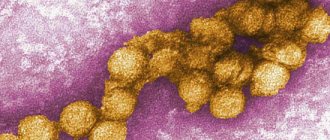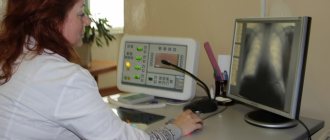Infectious disease specialist
Sinitsyn
Olga Valentinovna
33 years of experience
Highest qualification category of infectious disease doctor
Make an appointment
Dengue fever is an infectious disease transmitted by insects. The pathology has a clear geographic location and occurs more often in the countries of Southeast Asia, regions with a subtropical climate in Australia and South America. Due to the intensive development of tourism in these regions, cases of the disease are also observed in other countries, but they are isolated. Every year, Dengue fever is diagnosed in hundreds of thousands of people on the planet, some of whom do not have the opportunity to receive timely medical care and are forced to put up with serious complications of the infection.
Causes of Dengue Fever
The causative agent of the disease is the Dengue arbovirus, which can be found in the body of mosquitoes and arthropods. There are several serotypes, each of which gives approximately the same picture of the disease in the human body. The pathogen is resistant to climatic factors, however, it quickly dies under the influence of UV radiation and a sharp increase in ambient temperature.
The mechanism of transmission of the disease “Dengue fever” is associated with mosquitoes of the genus Aedes, which feed on the blood of humans and animals. When an infected subject is bitten, the pathogen enters the mosquito’s bloodstream, where it quickly multiplies without harming the host’s body. The incubation period can be up to 14 days, after which the insect and its bites become contagious. One contact of a Dengue fever carrier with a healthy body is enough for the virus to enter his blood, and the intensive development of the disease begins.
In the human body, the incubation period of the virus lasts about 7-15 days, and the acute stage lasts from 7 to 12 days. The course of the disease is wavy and consists of two peaks of increased body temperature, between which a weakening of symptoms is observed. However, this is not a reason to stop treatment, otherwise the risk of relapse and complications increases significantly.
Prevention
There are no drugs aimed at combating the virus, such as the causative agent of malaria. Until recently, there were no vaccinations against this problem either. However, today Thai scientists have managed to develop a vaccine that has proven effective in animal testing. The new drug, the invention of which took 30 years and the efforts of a huge team of scientists, is just about to undergo clinical trials in humans. But if they are successful, then within the next ten years the drug will go on sale.
Today, people can only exercise increased vigilance and strengthen protection against blood-sucking creatures.
Symptoms of the disease
After a mosquito bite, the virus penetrates the cells of the lymph nodes and blood vessels, where its intensive replication begins. As the volume of pathogenic particles increases, they spread throughout the body and penetrate the internal organs, partially blocking their functioning. An intoxication syndrome occurs, the first sign of which is a feverish state.
Other symptoms of Dengue fever include:
- headache;
- copious discharge from the respiratory tract;
- aches in muscles and joints;
- vomiting and nausea, other signs of digestive system disorder;
- diarrhea;
- drop in blood pressure level.
Key Facts
Dengue is a viral infection transmitted by mosquitoes.
The infection causes a flu-like illness and sometimes leads to a potentially fatal complication called severe dengue.
The global incidence of dengue has increased dramatically in recent decades. Currently, about half the world's population is at risk of the disease.
Dengue is common in tropical and subtropical climates throughout the world, mainly in urban and peri-urban areas.
There is no specific treatment for dengue/severe dengue, but with early detection and access to proper medical care, mortality rates can remain below 1%.
Related posts:
- Lymph nodes on the legs: symptoms Lymphadenitis is inflammation of the lymph nodes in a person caused by a reaction to a serious...
- Weight loss: causes of sudden weight loss and what to do Weight loss is a decrease in body weight within 5-15%...
- Jumping eyelid - what does it mean? Jitter eyelid or the so-called jumping eyelid is not something...
- Myasthenia gravis: what is it, causes, symptoms and treatment Myasthenia gravis is an acquired disease that relates to neuromuscular diagnoses. It appears...
Forms of the disease
The symptomatic picture allows us to classify the disease as follows:
The classic form of dengue fever. More often observed with primary lesions. Characteristic symptoms are a significant increase in body temperature, which after 3 days is replaced by normalization of the patient’s condition, after which the fever recurs. The disease is also indicated by signs of intoxication, muscle pain, discomfort in the spine, swelling of the face, neurological disorders such as dizziness and insomnia. The rash on the body that appears at the initial stage of the disease disappears after 3-7 days. The rash may resemble scarlet fever, appear as small hemorrhages, or appear as blisters.
Hemorrhagic form. It is more often observed in persons secondarily infected with the causative agent of Dengue fever. The incubation period can last up to 10 days, after which symptoms appear in the form of intoxication, lethargy and characteristic rashes. The latter can appear from several points to an extensive spot, which often has complications in the form of nosebleeds and internal hemorrhages. Blood particles are observed in the patient's stool and urine.
Dengue fever in children. In a child’s body, the pathogen makes itself felt with vague symptoms, which complicates diagnosis and does not allow timely treatment measures to be taken. More often, patients experience symptoms of Dengue fever such as intoxication syndrome, fever and rash, dry cough and difficulty breathing. The duration of the disease is about 7 days.
Pakbara - Hat Yai (continent)
We were met by an ambulance team in a reanimobile. The patient was placed on a gurney, causing increased attention from everyone waiting for the transfer on the pier. They turned on the flashing lights and rushed off, not stopping at traffic lights and overtaking the flow of oncoming traffic.
The hospital in Hat Yai is of an international level: an emergency department with equipment, comfortable and modern boxes. But we didn’t meet a single European there: the patients and medical staff were Thai.
About 8 people examined Vinsky, standing around the gurney. My feet looked and I felt extremely uncomfortable because my feet were dirty - on Koh Lipe I walked barefoot on the ground and sand. They brought it to a box for one - it was great: spacious, bright, there was a TV. But there are two of us. - Do you have something better and bigger? — There is a luxury suite, but it costs more than the one we agreed on with the insurance company. - No question - we will pay the difference. And we were transferred to a two-room apartment with two bathrooms, a kitchen and panoramic views of the city of Hat Yai. An important point: the next day the insurance company confirmed that it would cover these costs itself and in full .
Diagnostic methods
The doctor makes a preliminary diagnosis already at the stage of the initial examination and medical history. Unmistakable signs of fever are skin rashes, swollen lymph nodes, pain in the joints and muscles, as well as the wave-like development of a feverish state. If the patient has recently been to countries that are “dangerous” from the point of view of infection, he is immediately sent for laboratory tests:
- A polymerase chain reaction method that allows you to detect the presence of virus particles in the blood. Due to its high accuracy, it is of priority importance in diagnosis.
- Serological methods of blood testing, through which it is possible to clarify the presence of antibodies to the causative agent in the blood.
- General blood analysis. When the level of leukocytes and platelets decreases relative to the normative level, we can speak of a pathological state of the body.
Differentiated diagnostics allows you to accurately determine the fact of infection. Its goal is to exclude malaria, influenza, measles and rubella, which at the initial stage of the disease have similar symptoms.
The hemorrhagic form of dengue fever can be determined using the so-called flagella test. A tourniquet is applied to the patient’s upper limb, after which, after removing it five minutes later, new areas of rash can be noticed on the skin.
Evacuation from Koh Lipe to Hat Yai Hospital
There was no improvement. The three of us (Sergei, the doctor and I) struggled mentally with doubts about the necessary difficult evacuation and the progress of recovery. The sea was stormy.
The turning point came on January 1st. The temperature dropped to 38, but along with it the pressure and platelet level in the blood dropped to a critical level of 30 thousand (it was 150).
There was a threat of internal bleeding. Evacuation turned out to be inevitable. The speedboat was ordered, but they were waiting for the weather and tide. Another sleepless night and the morning of January 2 came.
The doctor himself arrived in Akira at 6.30 am to examine the patient and took another blood test. There was little hope of staying on Koh Lipe. But platelets dropped even lower overnight.
The speedboat picked us up right outside the Akira Hotel. We left our things at the hotel, hoping to return in a couple of days and continue our vacation on the island.
The doctor's assistant went with us on a speedboat to Pakbara. On the way, the speedboat rocked strongly and blood vessels on Sergei’s legs began to burst from the load - his legs began to turn black.
Treatment
A mandatory requirement for the patient when treating Dengue fever is immediate hospitalization. Treatment is carried out under the strict supervision of a doctor and includes the following medications:
- Painkillers and anti-inflammatory drugs.
- Sleeping pills and sedatives.
- Glucocorticosteroids to eliminate symptoms of intoxication.
- Antibiotics that destroy pathogens.
- Multivitamin complexes to support the immune system.
To prevent dehydration when treating symptoms of Dengue fever, drinking plenty of fluids and infusion therapy (drips) with glucose preparations are recommended.
Complications
The classic type of fever in pediatric patients does not cause complications of the disease.
The hemorrhagic type of dengue disease can lead to pathological conditions:
- bleeding;
- jaundice;
- disturbance of consciousness;
- rapid breathing;
- pallor of the epidermis;
- states of shock;
- rapid pulse.
In adult patients, complications of dengue fever manifest themselves as:
- infectious-toxic shock;
- otitis;
- meningitis;
- mumps;
- pneumonia;
- psychosis;
- encephalitis.
Diagnosis and treatment of Dengue fever at the clinic of JSC "Medicine"
If you discover signs of a dangerous disease after returning from countries in the tropical region of Asia, immediately make an appointment with an infectious disease specialist at the JSC Medicine clinic. At your service is our own diagnostic center and outpatient clinic, where you can undergo a treatment course under the supervision of a specialist. Each visitor is guaranteed attentive attention, confidentiality, and a full range of necessary diagnostic and therapeutic procedures. Appointments can be made online and by telephone during business hours.
Conclusions about medicine on Koh Lipe
1. When applying through an insurance company or at your own expense, avoid the Siam International clinic on Walking street. The other two (see above) have a decent level of service. In one we treated ourselves, about the second I heard positive reviews similar to ours. 2. If you pay in cash without insurance, bargain for every penny . 3. No insurance company will provide you with a translator. They simply aren't on the island. Without English (or Thai) in the hospital it will be difficult. 4. Better not get sick!
Symptoms of hemoragic shock syndrome
Shock syndrome develops in a third of patients.
It is graded according to four degrees of severity, namely:
- First degree - the presence of fever, general toxic syndrome, the skin near the bend of the elbow acquires hemorrhage if a tourniquet is applied;
- Second degree - spontaneous bleeding from the mucous membranes and skin occurs;
- Third degree - signs of insufficient blood circulation develop - the pulse quickens, but weakens, there is a decrease in blood pressure and body temperature, the person becomes restless;
- Fourth degree - decompensated shock develops - blood pressure cannot be determined. Hematocrit increases by 20 percent, progressing to thrombocytopenia.
A successful outcome requires adequate and timely intensive care. In other cases, more than half of those infected die after 4-5 days after infection with the Dengue virus.
The immune response that occurs in response to pathogen invasion eventually begins to ensure the elimination of viruses.
In case of infection with viruses of other serotypes, secondary infection begins, which accompanies an increased risk of developing a severe form.
Epidemiology
Sick people and primates act as reservoirs and sources of infection (Africa, Malaysia). Infection with the virus is carried out through its transmission by female mosquitoes Aedes aegypti and Aedes Albopictus (you can see what mosquitoes look like in the photo below).
Infected people can transmit the pathogen for four to twelve days after the first symptoms of the disease appear. Mosquitoes remain infected throughout their lives, which is about 1-4 months. Tropical regions are characterized by year-round transmission of the virus, with the exception of the rainy season. Outbreaks are recorded within the city, rural areas, and jungles.
Dengue has universal susceptibility; children and non-immune individuals are most susceptible to infection. During an epidemic, 50-70 percent of the population of a certain region is affected.
Speaking about the main mechanisms of Dengue transmission, we can highlight:
- Transmissible - blood;
- During an injection with an infected needle;
- During a bone marrow transplant from a person who has been infected.







